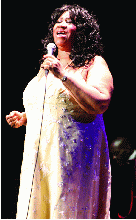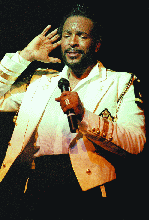The Evolution Of Music Part-V
The Evolution Of Music Part-V
R & B and Soul
 R&B, an abbreviation for rhythm and blues, is a style that arose in the 1930s and 1940s. Early R&B consisted of large rhythm units “smashing away behind screaming blues singers (who) had to shout to be heard above the clanging and strumming of the various electrified instruments and the churning rhythm sections”. R&B was not extensively recorded and promoted because record companies felt that it was not suited for most audiences, especially middle-class whites, because of the suggestive lyrics and driving rhythms.
R&B, an abbreviation for rhythm and blues, is a style that arose in the 1930s and 1940s. Early R&B consisted of large rhythm units “smashing away behind screaming blues singers (who) had to shout to be heard above the clanging and strumming of the various electrified instruments and the churning rhythm sections”. R&B was not extensively recorded and promoted because record companies felt that it was not suited for most audiences, especially middle-class whites, because of the suggestive lyrics and driving rhythms.
Band leaders like Louis Jordan innovated the sound of early R&B, using a band with a small horn section and prominent rhythm instrumentation. By the end of the 1940s, he had had several hits, and helped pave the way for contemporaries like Wynonie Harris and John Lee Hooker. Many of the most popular R&B songs were not performed in the rollicking style of Jordan and his contemporaries; instead they were performed by white musicians like Pat Boone in a more palatable mainstream style, which turned into pop hits.
By the end of the 1950s, however, there was a wave of popular black blues-rock and country-influenced R&B performers like Chuck Berry gaining unprecedented fame among white listeners.
Soul music is a combination of rhythm and blues and gospel which began in the late 1950s in the United States. It is characterized by its use of gospel-music devices, with a greater emphasis on vocalists and the use of secular themes. The 1950s recordings of Ray Charles, Sam Cooke, and James Brown are commonly considered the beginnings of soul. Charles’ Modern Sounds (1962) records featured a fusion of soul and country music, country soul, and crossed racial barriers in music at the time. One of Cooke’s most well-known songs “A Change Is Gonna Come” (1964) became accepted as a classic and an anthem of the civil rights movement of the 1960s. The Motown Record Corporation of Detroit, Michigan became highly successful during the early and mid 1960s by releasing soul recordings with heavy pop influences to make them palatable to white audiences, allowing black artists to more easily crossover to white audiences.
Pure soul was popularized by Otis Redding and the other artists of Stax Records in Memphis, Tennessee. By the late 1960s,  Atlantic recording artist Aretha Franklin had emerged as the most popular female soul star in the country. Also by this time, soul had splintered into several genres, influenced by psychedelic rock and other styles. The social and political ferment of the 1960s inspired artists like Marvin Gaye and Curtis Mayfield to release albums with hard-hitting social commentary, while another variety became more dance-oriented music, evolving into funk. Despite his previous affinity with politically and socially-charged lyrical themes, Gaye helped popularize sexual and romance-themed music and funk, while his 1970s recordings, including Let’s Get It On (1973) and I Want You (1976) helped develop the quiet storm sound and format. One of the most influential albums ever recorded, Sly & the Family Stone’s There’s a Riot Goin’ On (1971) has been considered among the first and best examples of the matured version of funk music, after prototypical instances of the sound in the group’s earlier work.[80] Spoken word soul, an eclectic blend of poetry, jazz-funk and soul was practiced by such artists as Gil Scott-Heron and The Last Poets, and featured critical political and social commentary with afro - centric sentiment. Scott-Heron’s proto-rap work, including “The Revolution Will Not Be Televised” (1971) and “Winter in America” (1974), has had a considerable impact on later hip hop artists, while his unique sound with Brian Jackson influenced neo soul artists.
Atlantic recording artist Aretha Franklin had emerged as the most popular female soul star in the country. Also by this time, soul had splintered into several genres, influenced by psychedelic rock and other styles. The social and political ferment of the 1960s inspired artists like Marvin Gaye and Curtis Mayfield to release albums with hard-hitting social commentary, while another variety became more dance-oriented music, evolving into funk. Despite his previous affinity with politically and socially-charged lyrical themes, Gaye helped popularize sexual and romance-themed music and funk, while his 1970s recordings, including Let’s Get It On (1973) and I Want You (1976) helped develop the quiet storm sound and format. One of the most influential albums ever recorded, Sly & the Family Stone’s There’s a Riot Goin’ On (1971) has been considered among the first and best examples of the matured version of funk music, after prototypical instances of the sound in the group’s earlier work.[80] Spoken word soul, an eclectic blend of poetry, jazz-funk and soul was practiced by such artists as Gil Scott-Heron and The Last Poets, and featured critical political and social commentary with afro - centric sentiment. Scott-Heron’s proto-rap work, including “The Revolution Will Not Be Televised” (1971) and “Winter in America” (1974), has had a considerable impact on later hip hop artists, while his unique sound with Brian Jackson influenced neo soul artists.
 During the mid-1970s, some highly slick and commercial bands like The O’Jays and Hall & Oates achieved mainstream success with styles like Philly soul and blue-eyed soul. By the end of the ’70s, soul, funk, rock and most other genres were dominated by tracks influenced by disco; a kind of popular dance music. With the introduction of influences from electro music and funk in the late 1970s and early 1980s, soul music became less raw and more slickly produced, resulting in a genre of music that was once again called R&B, usually distinguished from the earlier rhythm and blues by identifying it as contemporary R&B.
During the mid-1970s, some highly slick and commercial bands like The O’Jays and Hall & Oates achieved mainstream success with styles like Philly soul and blue-eyed soul. By the end of the ’70s, soul, funk, rock and most other genres were dominated by tracks influenced by disco; a kind of popular dance music. With the introduction of influences from electro music and funk in the late 1970s and early 1980s, soul music became less raw and more slickly produced, resulting in a genre of music that was once again called R&B, usually distinguished from the earlier rhythm and blues by identifying it as contemporary R&B.
The first contemporary R&B stars arose in the 1980s, with the funk-influenced singer Prince, dance-pop star Michael Jackson, and a wave of female vocalists like Tina Turner and Whitney Houston. Hip hop came to influence contemporary R&B later in the ’80s, first in a style called new jack swing and then in a related series of subgenres called hip hop soul and neo soul. New jack swing was a style and trend of  vocal music, often featuring rapped verses and drum machines. Hip hop soul and neo soul developed later, in the 1990s. Typified by the work of Mary J. Blige and R. Kelly, the former is a mixture of contemporary R&B with hip hop beats, while the images and themes of gangsta rap may be present. The latter is a more experimental, edgier and generally less mainstream combination of ’60s and ’70s style soul vocals with some hip hop influence, and has earned some mainstream recognition through the work of D’Angelo, Erykah Badu and Lauryn Hill.
vocal music, often featuring rapped verses and drum machines. Hip hop soul and neo soul developed later, in the 1990s. Typified by the work of Mary J. Blige and R. Kelly, the former is a mixture of contemporary R&B with hip hop beats, while the images and themes of gangsta rap may be present. The latter is a more experimental, edgier and generally less mainstream combination of ’60s and ’70s style soul vocals with some hip hop influence, and has earned some mainstream recognition through the work of D’Angelo, Erykah Badu and Lauryn Hill.



